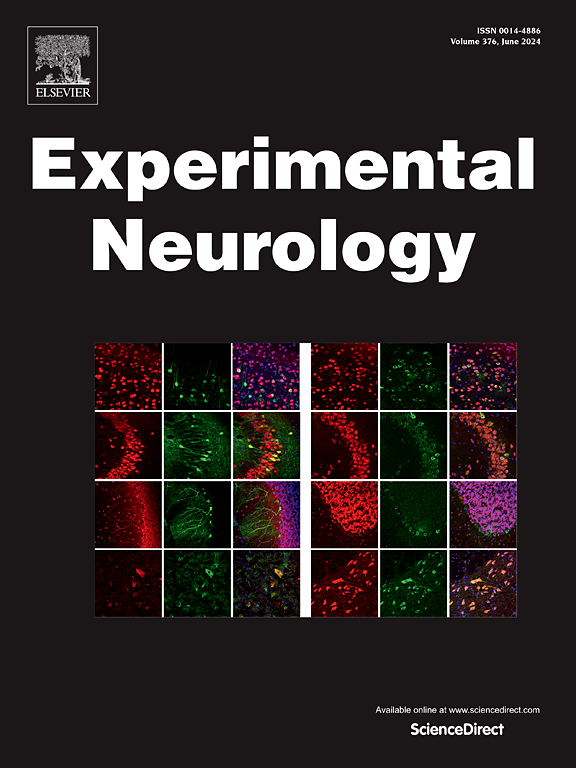Cold atmospheric plasma-activated saline alleviates secondary injury post-SCI by inhibiting extracellular matrix remodeling and infiltration of proinflammatory macrophages
IF 4.6
2区 医学
Q1 NEUROSCIENCES
引用次数: 0
Abstract
Background
Cold atmospheric plasma (CAP) has been shown to improve the recovery of transected peripheral nerves. We determined the protective role of CAP-activated saline (CAP-AS) treatment in the acute and subacute stages of spinal cord injury (SCI) in mice.
Methods
C57BL/6 SCI mice were treated with CAP-AS for 14 days. Injury recovery was assessed weekly for four weeks by conducting motor function tests, including the Basso Mouse Scale (BMS) and footprint test. Transcriptome analysis was conducted on day 14 to elucidate potential mechanisms, which were further validated through immunofluorescence examinations of the injured spinal cord tissues on day 28 and the levels of proinflammatory cytokines produced by macrophages in vitro.
Results
Compared to the SCI group, the CAP-AS-treated groups presented significantly better hindlimb motor function after four weeks. The downregulated (SCI vs. SCI + CAP-AS, with CAP-AS activated for 20 min) differentially expressed genes (DEGs) were enriched in the extracellular region, extracellular matrix (ECM), and ECM-receptor interaction. In contrast, the upregulated DEGs were enriched in immune response-associated pathways. Histological changes in the CAP-AS-treated groups were observed to further validate the predicted mechanisms 28 days post-injury. The alleviation of secondary injury was confirmed by an increase in GFAP-positive and NFH-positive areas, and enhanced outgrowth of 5-HT-positive fibers. Inhibited ECM remodeling was confirmed by a decrease in the areas positive for PDGFRβ, fibronectin, and laminin. A decrease in the infiltration of macrophages and activation of microglia was determined by a decrease in CD68-positive and F4/80-positive areas. The inhibitory effect of CAP-AS on inflammation was further supported by a decrease in the levels of the proinflammatory cytokines IL-1β, IL-6, and TNF-α in CAP-AS-treated M1 macrophages.
Conclusion
CAP-AS can alleviate secondary injury in SCI model mice by inhibiting ECM remodeling in injured tissues and reducing the infiltration or activation of proinflammatory macrophages/microglia.

冷大气等离子体活化生理盐水通过抑制细胞外基质重塑和促炎巨噬细胞的浸润,减轻了 SCI 后的继发性损伤。
背景:冷大气等离子体(CAP)已被证明可改善横断周围神经的恢复。我们确定了 CAP 活性生理盐水(CAP-AS)治疗对脊髓损伤(SCI)小鼠急性和亚急性阶段的保护作用:C57BL/6 SCI 小鼠接受 CAP-AS 治疗 14 天。每周进行一次运动功能测试,包括巴索小鼠量表(Basso Mouse Scale,BMS)和足印测试,连续四周评估损伤恢复情况。第 14 天进行了转录组分析,以阐明潜在的机制,并通过第 28 天对损伤脊髓组织的免疫荧光检查和体外巨噬细胞产生的促炎细胞因子水平进一步验证了这些机制:与 SCI 组相比,CAP-AS 治疗组的后肢运动功能在四周后明显改善。下调(SCI 与 SCI + CAP-AS,CAP-AS 激活 20 分钟)的差异表达基因(DEGs)富集在细胞外区域、细胞外基质(ECM)和 ECM 与受体的相互作用中。相反,上调的 DEGs 则富集在免疫反应相关通路中。通过观察 CAP-AS 治疗组的组织学变化,进一步验证了损伤后 28 天的预测机制。GFAP 阳性和 NFH 阳性区域的增加以及 5-HT 阳性纤维的生长增强证实了继发性损伤的缓解。PDGFRβ、纤连蛋白和层粘连蛋白阳性区域的减少证实了 ECM 重塑受到抑制。巨噬细胞浸润和小胶质细胞活化的减少是通过 CD68 阳性和 F4/80 阳性区域的减少来确定的。经 CAP-AS 处理的 M1 巨噬细胞中促炎细胞因子 IL-1β、IL-6 和 TNF-α 水平的降低进一步证实了 CAP-AS 对炎症的抑制作用:结论:CAP-AS 可抑制损伤组织中 ECM 的重塑,减少促炎巨噬细胞/小胶质细胞的浸润或激活,从而减轻 SCI 模型小鼠的继发性损伤。
本文章由计算机程序翻译,如有差异,请以英文原文为准。
求助全文
约1分钟内获得全文
求助全文
来源期刊

Experimental Neurology
医学-神经科学
CiteScore
10.10
自引率
3.80%
发文量
258
审稿时长
42 days
期刊介绍:
Experimental Neurology, a Journal of Neuroscience Research, publishes original research in neuroscience with a particular emphasis on novel findings in neural development, regeneration, plasticity and transplantation. The journal has focused on research concerning basic mechanisms underlying neurological disorders.
 求助内容:
求助内容: 应助结果提醒方式:
应助结果提醒方式:


